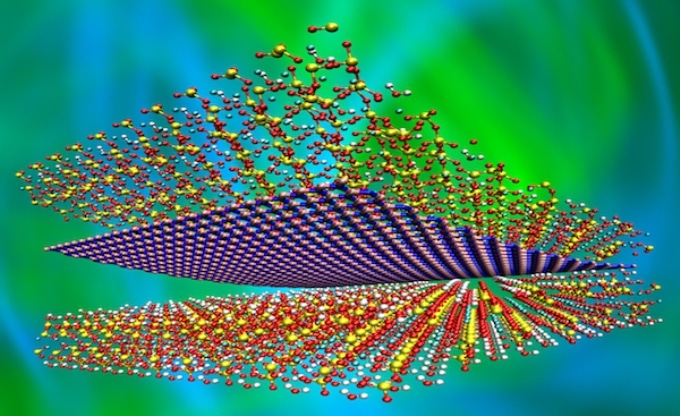Jan 12 2018
According to a Rice University researcher, a little hBN in ceramics could give them exceptional properties.
 Bilayer white graphene (middle layer) combined with calcium-silicate creates a multifunctional ceramic with high strength and toughness, according to a Rice University lab. The material may be suitable for construction and refractory materials and applications in the nuclear industry, oil and gas, aerospace and other areas that require high-performance composites. (Image credit: Rouzbeh Shahsavari)
Bilayer white graphene (middle layer) combined with calcium-silicate creates a multifunctional ceramic with high strength and toughness, according to a Rice University lab. The material may be suitable for construction and refractory materials and applications in the nuclear industry, oil and gas, aerospace and other areas that require high-performance composites. (Image credit: Rouzbeh Shahsavari)
Rouzbeh Shahsavari, an Assistant Professor of civil and environmental engineering, proposed that the addition of ultrathin hexagonal boron nitride (hBN) sheets between layers of calcium-silicates would make a remarkable bilayer crystal with multifunctional properties. These could be ideal for construction and refractory materials, as well as applications in the nuclear industry, aerospace, oil and gas and other areas that necessitate high-performance composites.
Merging the materials would make a ceramic that is not only durable and tough but also resistant to radiation and heat. By Shahsavari’s calculations, calcium-silicates with inserted layers of two-dimensional hBN could be hardened sufficiently to serve as shielding in nuclear applications such as power plants.
Details of the research have been published in the American Chemical Society journal ACS Applied Materials and Interfaces.
Two-dimensional hBN is dubbed white graphene and resembles graphene from above, with linked hexagons forming an ultrathin plane. But hBN varies from graphene as it contains alternating nitrogen and boron, rather than carbon atoms.
This work shows the possibility of material reinforcement at the smallest possible dimension, the basal plane of ceramics. This results in a bilayer crystal where hBN is an integral part of the system as opposed to conventional reinforcing fillers that are loosely connected to the host material.
Our high-level study shows energetic stability and significant property enhancement owing to the covalent bonding, charge transfer and orbital mixing between hBN and calcium silicates.
Rouzbeh Shahsavari, Assistant Professor of Civil and Environmental Engineering
The form of ceramic the lab investigated, known as tobermorite, is inclined to self-assemble in layers of oxygen and calcium kept together by silicate chains as it dries into hardened cement. Shahsavari’s molecular-scale research reveals that hBN blends well with tobermorite abd slips into the spaces between the layers as the boron and oxygen atoms bind, buckling the flat hBN sheets.
This accordion-like buckling is because of the chemical affinity and charge transfer between the boron atoms and tobermorite that steadies the composite and provides it high strength and toughness, properties that typically trade off against each other in engineered materials, Shahsavari said. The explanation seems to be a two-phase mechanism that occurs when the hBN layers are subjected to stress or strain.
Shahsavari’s models of horizontally stacked tobermorite and tobermorite-hBN demonstrated the composite was three times stronger and approximately 25 % stiffer than the plain material. Computational analysis exposed why: While the silicate chains in tobermorite did not work when forced to rotate along their axes, the hBN sheets relieved the stress by initially unbuckling and then stiffening.
When compressed, plain tobermorite exhibited a low yield strength (or elastic modulus) of around 10 gigapascals (GPa) with a yield strain (the point at which a material deforms) of 7 %. The composite exhibited yield strength of 25 GPa and strain up to 20 %.
“A major drawback of ceramics is that they are brittle and shatter upon high stress or strain,” Shahsavari said. “Our strategy overcomes this limitation, providing enhanced ductility and toughness while improving strength properties.
“As a bonus, the thermal and radiation tolerance of the system also increases, rendering multifunctional properties,” he said. “These features are all important to prevent deterioration of ceramics and increase their lifetime, thereby saving energy and maintenance costs.”
When the material was analyzed from other angles, variances between the pure tobermorite and the composite were less obvious, but on average, hBN enhanced considerably the material’s properties.
Compared with one-dimensional fillers such as conventional fibers or carbon nanotubes, 2D materials like hBN are two-sided, so they have twice the surface area per unit mass. This is perfect for reinforcement and adhesion to the surrounding matrix.
Rouzbeh Shahsavari, Assistant Professor of Civil and Environmental Engineering
He said other 2D materials like niobium diselenide molybdenum disulfide and layered double hydroxide may also be ideal for the bottom-up design of high-performance ceramics and other multifunctional composite materials.
The research was supported by the National Science Foundation. Supercomputing resources were supplied by the National Institutes of Health and an IBM Shared University Research Award in partnership with Cisco, Qlogic and Adaptive Computing, as well as Rice’s National Science Foundation-supported DAVinCI supercomputer administered by the Center for Research Computing and procured in partnership with Rice’s Ken Kennedy Institute for Information Technology.